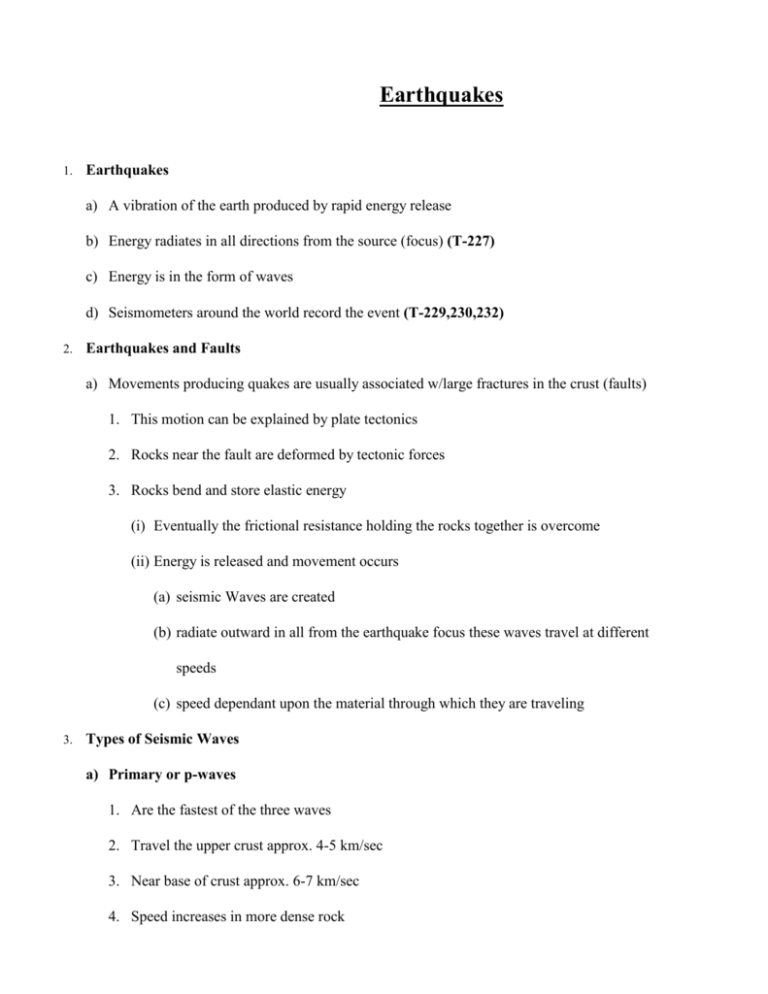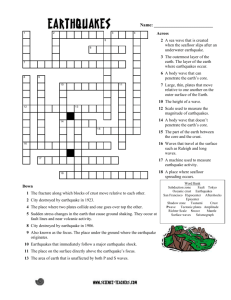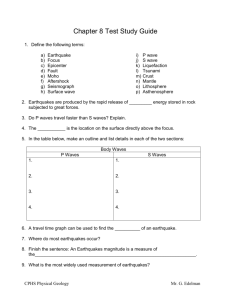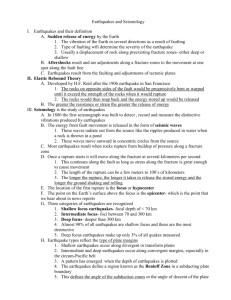Ch 11
advertisement

Earthquakes 1. Earthquakes a) A vibration of the earth produced by rapid energy release b) Energy radiates in all directions from the source (focus) (T-227) c) Energy is in the form of waves d) Seismometers around the world record the event (T-229,230,232) 2. Earthquakes and Faults a) Movements producing quakes are usually associated w/large fractures in the crust (faults) 1. This motion can be explained by plate tectonics 2. Rocks near the fault are deformed by tectonic forces 3. Rocks bend and store elastic energy (i) Eventually the frictional resistance holding the rocks together is overcome (ii) Energy is released and movement occurs (a) seismic Waves are created (b) radiate outward in all from the earthquake focus these waves travel at different speeds (c) speed dependant upon the material through which they are traveling 3. Types of Seismic Waves a) Primary or p-waves 1. Are the fastest of the three waves 2. Travel the upper crust approx. 4-5 km/sec 3. Near base of crust approx. 6-7 km/sec 4. Speed increases in more dense rock 5. Travel through solids, liquids and gases 6. Speed decreases in liquids b) Secondary or s-waves 1. Travel 1-2 km/sec slower than p-waves 2. Do not travel through liquids 3. Speed increases in more dense rock c) Surface waves 1. Large motion waves travel thru outer crust o 2. Develop when p/s waves disturb the surface 3. These are the primary cause of destruction 4. Terms: a) Foreshocks -small quakes occurring prior to major quake b) Aftershocks -small quakes occurring after major quake c) Focus -point where the seismic wave originates d) Epicenter -point on the surface of the earth 1. located directly above the focus 2. 5. San Andreas most studied fault system in the world 1. Displacement occurs along segments 100 to 200 km long 2. Some areas have slow, gradual displacement (fault creep) 3. Some areas regularly slip producing small earthquakes 4. Other areas store elastic energy for 100’s of years 5. San Andreas great earthquake every 50 – 200 years 6. (last big one 1906) 6. Where Do Earthquakes Occur? 95% occur w/in narrow zones (T-235,236) a) Circum-Pacific Belt-deep b) Mediterranean-Himalayan Belt c) Oceanic Ridge System-shallow 7. The quantification of an earthquake is determined by: a) Intensity- measure of the earthquakes effect on people and buildings 1. modified Mercalli scale Roman numeral I to XII (T-227) b) Magnitude- a measure of the energy released during the earthquakeRichter scale 0 to 8.6 1. The Richter scale is logarithmic, i.e. increase of 1 = 10 X increase in amplitude and 30 times increase in energy released (T-252) c) Seismograph-utilized to record information about an earthquake 8. Earth’s Interior- learned through studies of seismic waves 9. Mohorovicic Discontinuity -boundary b/w crust and upper mantle (a) 30-40 km beneath surface of continents shallower below oceans) 10. Guttenberg Discontinuity - 2900 km deep (a) boundary of the liquid outer core (b) P-wave velocity decreases/S-waves disappear. 11. Effects of earthquakes a) Groundmotion-shaking of land surface b) Fire- broken gas, water & electrical lines c) Landslides- movement of soil rock & rock d) Aftershocks-small earthquakes that follow the main shock, can last for months e) Tsunamis/Seismic Sea/Tidal Waves (T-240,246) 1. Caused by the sudden movement of the sea floor 2. Can generate tremendous waves. 100 miles long, 100 ft tall and up to 450 mph 12. Earthquake Prediction a) Monitor movement in rocks in earthquake b) prone regions c) Monitor animal behavior d) Fluctuations in the water table elevation 13. Earthquake control a) Introduce volumes of water into subsurface b) Minor planned explosions c) These actions will trigger numerous small earthquakes releasing the strain in the rocks and therefore prevent large earthquakes









